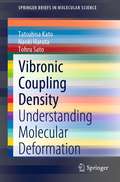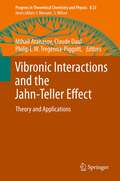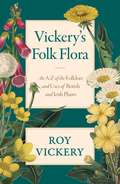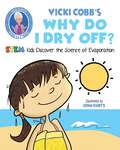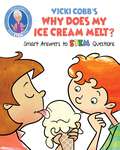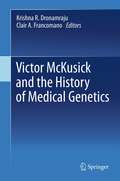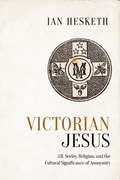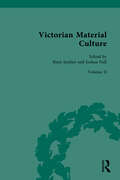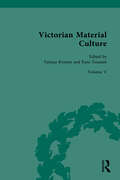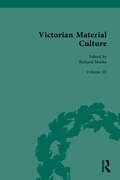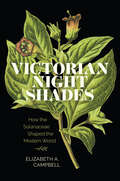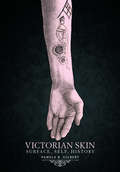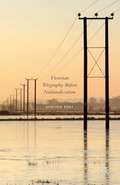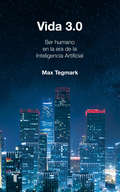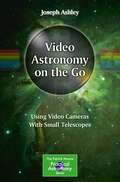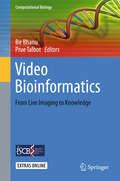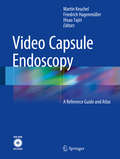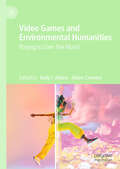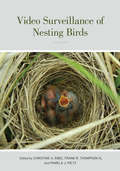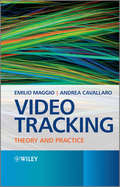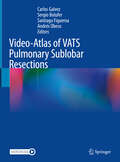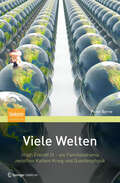- Table View
- List View
Vibronic Coupling Density: Understanding Molecular Deformation (SpringerBriefs in Molecular Science)
by Tatsuhisa Kato Naoki Haruta Tohru SatoThis book introduces vibronic coupling density and vibronic coupling constant analyses as a way to understand molecular structure and chemical reactions. After quantum study, the behavior of electrons circulating around nuclei led to the principal concept that underlies all explanations in chemistry. Many textbooks have given plausible explanations to clarify molecular structure—for example, the bond elongation of ethylene under anionization and the nonplanar structure of ammonia. Frontier molecular orbital concepts were proposed to visualize the path of chemical reactions, and conventional explanations gave students a familiarity with molecular structures in terms of the electronic state. By contrast, this book offers a more rational and more convincing path to understanding. It starts from the ab initio molecular Hamiltonian and provides systematic, rational approaches to comprehend chemical phenomena. In this way, the book leads the reader to a grasp of the quantitative evaluation of the force applied under the molecular deformation process. As well, guidelines are offered for integrating the traditional “hand-waving” approach of chemistry with more rational and general VCD and VCC alternatives along with the outlook for newly functionalized chemical systems.
Vibronic Interactions and the Jahn-Teller Effect
by Claude Daul Mihail Atanasov Philip L.W. Tregenna-PiggottThe concepts of the Jahn-Teller effect and vibronic coupling are being applied to more and more systems in both chemistry and physics. Aspects of structural chemistry such as the distortion of the nuclear framework to a lower-symmetry conformation have received an increasing attention, as well as the dynamics on the coupled potential energy surfaces. The Jahn-Teller intersections are now recognized as prototype cases of conical intersections where the nuclear motion is known to be inherently nonadiabatic in nature and interchanges freely between the different potential energy surfaces. In the condensed phase especially, the significance of the Jahn-Teller effect has been increasingly appreciated, following the discovery of superconductivity in the fullerides and of very large ("colossal") magnetoresistance in the manganite perovskites. Indeed, these materials are particularly challenging since the Jahn-Teller interaction competes with electronic correlation effects. Vibronic Interactions and the Jahn-Teller Effect: Theory and Applications provides an in-depth discussion of the Jahn-Teller effect and vibronic interactions as reflected by the contributions presented at the XX International Conference on the Jahn-Teller effect, Fribourg, Switzerland, 2010. The following topics have been treated in a clear and concise way: * Complex topologies of Jahn-Teller effect and conical intersections * Multi-state vibronic interactions on strongly coupled potential energy surfaces * Interplay of vibronic and spin-orbit coupling * Strain in Jahn-Teller systems and cooperative Jahn-Teller effect * Orbital ordering and its relation to ferromagnetism, ferroelectricity and molecular magnets * The Jahn-Teller effect in icosahedral systems * The Jahn-Teller effect and high temperature superconductivity This book is of interest to a wide audience including academic and industrial theoretical and experimental physicists, chemists, spectroscopists, and crystallographers.
Vickery's Folk Flora: An A-Z of the Folklore and Uses of British and Irish Plants
by Roy VickeryThis book is a dictionary of British (native, naturalised and cultivated) plants and the folklore associated with them. Unlike many plant-lore publications Vickery's Folk Flora tells us what people currently do and believe, rather than what Victorians did and believed. The result is a vivid demonstration that plant folklore in the British Isles is not only surviving but flourishing; adapting and evolving as time goes by, even in urban areas.Each entry includes:- The plant's English and scientific (Latin) name, as well as significant local names.- A brief description of the plant and its distribution, and, in the case of cultivated plants, a history of their introduction to the British Isles- Information on the folklore and traditional uses of the plant, arranged where possible in a sequence starting with general folk beliefs (superstitions), use in traditional customs, use in folk medicine, other uses, and legends concerning individual representatives of the plant.In addition to the major entries there are a number of minor entries for feast days, diseases and other subjects which direct readers to relevant major entries, e.g. St. George's Day, on which red roses are worn; dandelions are gathered; and runner beans are planted.
Vicki Cobb's Why Do I Dry Off?: STEM Kids Discover the Science of Evaporation (STEM Play)
by Vicki CobbHow do you dry off? Find out how in this new, colorful, easy-to-read STEM book! &“STEM&” is an acronym for Science, Technology, Engineering, and Math. Though these subjects are incredibly important to both education and society as a whole, they are often overlooked, especially after primary education is complete. A goal of this book is to introduce STEM to kids and make them excited about learning these central subjects. In Why Do I Dry Off?, your child will learn all about evaporation and the process of liquid changing into gas, an important part of the water cycle. Accomplished author and educator Vicki Cobb teaches your child all about this important aspect of STEM, while still making it fun and entertaining through bright illustrations, easy-to-understand language, and experiments broken down step-by-step. Your child will be so enthralled, they won&’t even realize they&’re learning! Introduce your child to vital STEM subjects and encourage them to learn about the world around them with Why Do I Dry Off?!
Vicki Cobb's Why Does My Ice Cream Melt?: Smart Answers to STEM Questions (STEM Play)
by Vicki CobbWhy does ice cream melt? Find out how in this new, colorful, easy-to-read STEM book! &“STEM&” is an acronym for Science, Technology, Engineering, and Math. Though these subjects are incredibly important to both education and society as a whole, they are often overlooked, especially after primary education is complete. A goal of this book is to introduce STEM to kids and make them excited about learning these central subjects. In Why Does My Ice Cream Melt?, your child will learn all about the states of water, including the water cycle. Accomplished author and educator Vicki Cobb teaches your child all about this important aspect of STEM, while still making it fun and entertaining through bright illustrations, easy-to-understand language, and experiments broken down step-by-step. Your child will be so enthralled, they won&’t even realize they&’re learning! Introduce your child to vital STEM subjects and encourage them to learn about the world around them with Why Does My Ice Cream Melt?!
Victim Advocacy before the International Criminal Court
by Elizabeth King Rianne Letschert Sam Garkawe Erin PobjieThis book is a practical guide for advocates interested in the representation of victims before the International Criminal Court (ICC). It has been developed by experts responsible for the advocacy training of the International Criminal Court's List of Counsel members. Written in a readily accessible style, this guide provides a firm grounding in relevant legal doctrine, essential advocacy techniques and valuable multidisciplinary perspectives. Drawing upon global expertise from legal practitioners, specialist advocacy trainers and multi-disciplinary writers, this book addresses both practical considerations and key challenges faced by ICC victim advocates. These include issues such as gender, child victims, victims of sexual violence, special need victims and victims who are themselves implicated in international crimes. Through its practical focus on advocacy techniques, hypothetical case studies, checklists, interviews from the field and lists of further resources, this manual equips readers with the knowledge and skills necessary to engage in sophisticated ICC victim advocacy. This book will also appeal to those interested in the workings of International Criminal Law and in victim advocacy and victimology more broadly.
Victor McKusick and the History of Medical Genetics
by Clair A. Francomano Krishna R. DronamrajuThis book is being planned as a tribute to Dr. Victor A. McKusick (1921-2008), who is well known as the "father of medical genetics". He was long associated with the Johns Hopkins University School of Medicine, first as a student in the 1940s, and later as a faculty member, becoming the Chairman of the Department of Medicine at Johns Hopkins. He was a co-founder of GENOMICS and founder and lifelong editor of Mendelian Inheritance in Man, a massive compendium of human syndromes and genetic variants. Dr. McKusick made distinguished contributions to all branches of medical genetics. He was a member of the U.S. National Academy of Sciences and many other academies in the world. He was awarded the National Medal of Science in 2002. He received many other honors including several honorary doctorates. The proposed book will reflect all the fields touched upon by Dr. McKusick's contributions. It will be a valuable source of the latest progress in medical genetics. The contributors are internationally distinguished in their chosen specialties. Besides professional distinction, they are being selected because of their past association with Dr. McKusick, as former students or colleagues who extended his research in some fashion. The proposed book will reflect all the fields touched upon by Dr. McKusick's contributions. It will be a valuable source of the latest progress in medical genetics. The contributors are internationally distinguished in their chosen specialties. Besides professional distinction, they are being selected because of their past association with Dr. McKusick, as former students or colleagues who extended his research in some fashion.
Victorian Jesus: J.R. Seeley, Religion, and the Cultural Significance of Anonymity
by Ian HeskethEcce Homo: A Survey in the Life and Work of Jesus Christ, published anonymously in 1865, alarmed some readers and delighted others by its presentation of a humanitarian view of Christ and early Christian history. Victorian Jesus explores the relationship between historian J. R. Seeley and his publisher Alexander Macmillan as they sought to keep Seeley’s authorship a secret while also trying to exploit the public interest. Ian Hesketh highlights how Ecce Homo's reception encapsulates how Victorians came to terms with rapidly changing religious views in the second half of the nineteenth century. Hesketh critically examines Seeley’s career and public image, and the publication and reception of his controversial work. Readers and commentators sought to discover the author’s identity in order to uncover the hidden meaning of the book, and this engendered a lively debate about the ethics of anonymous publishing. In Victorian Jesus, Ian Hesketh argues for the centrality of this moment in the history of anonymity in book and periodical publishing throughout the century.
Victorian Material Culture
by Joshua Nall Tatiana Kontou Victoria Mills Boris JardineFrom chatelaines to whale blubber, ice making machines to stained glass, this six-volume collection will be of interest to the scholar, student or general reader alike - anyone who has an urge to learn more about Victorian things. The set brings together a range of primary sources on Victorian material culture and discusses the most significant developments in material history from across the nineteenth century. The collection will demonstrate the significance of objects in the everyday lives of the Victorians and addresses important questions about how we classify and categorise nineteenth-century things. This second volume, ‘Science and Medicine’, will examine objects (from the most significant to the most obscure) that played a part in nineteenth-century scientific developments.
Victorian Material Culture
by Tatiana Kontou Victoria Mills Kara TennantFrom chatelaines to whale blubber, ice making machines to stained glass, this six-volume collection will be of interest to the scholar, student or general reader alike - anyone who has an urge to learn more about Victorian things. The set brings together a range of primary sources on Victorian material culture and discusses the most significant developments in material history from across the nineteenth century. The collection will demonstrate the significance of objects in the everyday lives of the Victorians and addresses important questions about how we classify and categorise nineteenth-century things. This collection brings together a range of primary sources on Victorian material and culture. This volume, ‘Fashionable Things’, will focus on Victorian fads and fashions ranging from chatelains to spiritualist Ouija boards.
Victorian Material Culture
by Richard Menke Tatiana Kontou Victoria MillsFrom chatelaines to whale blubber, ice making machines to stained glass, this six-volume collection will be of interest to the scholar, student or general reader alike - anyone who has an urge to learn more about Victorian things. The set brings together a range of primary sources on Victorian material culture and discusses the most significant developments in material history from across the nineteenth century. The collection will demonstrate the significance of objects in the everyday lives of the Victorians and addresses important questions about how we classify and categorise nineteenth-century things. This collection brings together a range of primary sources on Victorian material and culture. This third volume, ‘Invention and Technology’, will look at a variety of Victorian inventions, both foundational and short-lived.
Victorian Nightshades: How the Solanaceae Shaped the Modern World (Victorian Literature and Culture Series)
by Elizabeth A. CampbellA darkly alluring plant family and the arrival of modernityVictorian Nightshades tells the story of how one plant family—notorious for centuries in England because of its frequently psychoactive and poisonous properties—rose to social and economic prevalence during the nineteenth century. Beginning with bittersweet and belladonna, the Old World species associated with evil, witchcraft, and dangerous women in an era when traditional botanical beliefs not only assigned morality to plants but also gendered them, Campbell then moves to the ubiquitous potato and tobacco before concluding with four of the Solanaceae that achieved the widest national favor by the end of the century: the ornamental petunia and the edible pepper, eggplant, and tomato. The story of the nightshades exposes the conflicts between science and popular sentiment and between knowledge and received opinion that defined the nineteenth century. Campbell compellingly details how advances in medical and botanical knowledge, evolutionary theory, and the vagaries of human desire transformed the Solanaceae from a plant family plagued by fear and hostility in the British imagination to one of cultural favor and celebration by the turn of the century—encapsulating the Victorian era&’s course to modernity.
Victorian Skin: Surface, Self, History
by Pamela K. GilbertIn Victorian Skin, Pamela K. Gilbert uses literary, philosophical, medical, and scientific discourses about skin to trace the development of a broader discussion of what it meant to be human in the nineteenth century. Where is subjectivity located? How do we communicate with and understand each other's feelings? How does our surface, which contains us and presents us to others, function and what does it signify? As Gilbert shows, for Victorians, the skin was a text to be read. Nineteenth-century scientific and philosophical perspectives had reconfigured the purpose and meaning of this organ as more than a wrapping and instead a membrane integral to the generation of the self. Victorian writers embraced this complex perspective on skin even as sanitary writings focused on the surface of the body as a dangerous point of contact between self and others. Drawing on novels and stories by Dickens, Collins, Hardy, and Wilde, among others, along with their French contemporaries and precursors among the eighteenth-century Scottish thinkers and German idealists, Gilbert examines the understandings and representations of skin in four categories: as a surface for the sensing and expressive self; as a permeable boundary; as an alienable substance; and as the site of inherent and inscribed properties. At the same time, Gilbert connects the ways in which Victorians "read" skin to the way in which Victorian readers (and subsequent literary critics) read works of literature and historical events (especially the French Revolution.) From blushing and flaying to scarring and tattooing, Victorian Skin tracks the fraught relationship between ourselves and our skin.
Victorian Telegraphy Before Nationalization
by Simone FariThis study offers an analysis of the technological and entrepreneurial features of the Victorian telegraph service, together with the companies which ran it until nationalization in 1869. It shows a historical reconstruction mainly based on original and unedited documents belonging to a variety of archives.
Vida 3.0
by Max Tegmark¿Cómo afectará la inteligencia artificial al crimen, a la guerra, a la justicia, al trabajo, a la sociedad y al sentido de nuestras vidas? Bienvenidos a la conversación más importante de nuestro tiempo. ¿Cómo afectará la inteligencia artificial al crimen, a la guerra, a la justicia, al trabajo, a la sociedad y al sentido de nuestras vidas? ¿Es posible que las máquinas nos dejen fuera de juego, remplazando a los humanos en el mercado laboral e incluso en otros ámbitos? ¿La inteligencia artificial proveerá mejoras sin precedente a nuestras vidas o nos dará más poder del que podemos manejar? Muchas de las cuestiones más fundamentales de la actualidad están íntimamente relacionadas con el aumento de la inteligencia artificial. Max Tegmark no se asusta ante la gama completa de puntos de vista o ante los temas más controvertidos, desde la superinteligencia hasta el significado, la conciencia y los límites físicos últimos de la vida en el cosmos. En Vida 3.0, clarifica los conceptos clave necesarios para hablar de inteligencia artificial al tiempo que ayuda a entender la importancia de las cuestiones clave, aquellas que la humanidad tendrá que abordar en las próximas décadas. Reseñas:«Todos nosotros, no solo científicos, industriales y generales, deberíamos preguntarnos qué puede hacerse ahora para aumentar las posibilidades de cosechar los beneficios de la IA futura y evitar sus riesgos. Esta es la conversación más importante de nuestro tiempo, y con este estimulante libro Tegmark te ayudará a participar en ella.»Stephen Hawking «Enriquecedor y visionario. Todo el mundo debería leerlo.»The Times «Tegmark explica con brillantez numerosos conceptos del terreno de la informática al de la cosmología, escribe con modestia y sutileza intelectual, le ofrece al lector el importante servicio de definir sus términos con claridad, y con razón rinde homenaje a las mentes creativas de los escritores de ciencia ficción que, por supuesto, abordaron este tipo de preguntas hace más de medio siglo.»Steven Poole, The Telegraph «Original, accesible y provocador. Tegmark ilumina las numerosas facetas de la inteligencia artificial. Disfruten del viaje y saldrán del otro extremo con una mejor apreciación de adónde podría llevarnos la tecnología en los próximos años.»Science «Una guía convincente por los retos y dilemas en nuestra búsqueda de un gran futuro de la vida, la inteligencia y la consciencia, en la Tierra y más allá de esta.»Elon Musk Estimulante. La discusión inteligente y desenfrenada de Tegmark conduce a fascinantes especulaciones sobre civilizaciones basadas en la inteligencia artificial que abarcan galaxias y eones. Absorbente.»Publishers Weekly
Vida 3.0
by Max Tegmark¿Cómo afectará la inteligencia artificial al crimen, a la guerra, a la justicia, al trabajo, a la sociedad y al sentido de nuestras vidas? Bienvenidos a la conversación más importante de nuestro tiempo. ¿Cómo afectará la inteligencia artificial al crimen, a la guerra, a la justicia, al trabajo, a la sociedad y al sentido de nuestras vidas? ¿Es posible que las máquinas nos dejen fuera de juego, remplazando a los humanos en el mercado laboral e incluso en otros ámbitos? ¿La inteligencia artificial proveerá mejoras sin precedente a nuestras vidas o nos dará más poder del que podemos manejar? Muchas de las cuestiones más fundamentales de la actualidad están íntimamente relacionadas con el aumento de la inteligencia artificial. Max Tegmark no se asusta ante la gama completa de puntos de vista o ante los temas más controvertidos, desde la superinteligencia hasta el significado, la conciencia y los límites físicos últimos de la vida en el cosmos. En Vida 3.0, clarifica los conceptos clave necesarios para hablar de inteligencia artificial al tiempo que ayuda a entender la importancia de las cuestiones clave, aquellas que la humanidad tendrá que abordar en las próximas décadas. Reseñas:«Todos nosotros, no solo científicos, industriales y generales, deberíamos preguntarnos qué puede hacerse ahora para aumentar las posibilidades de cosechar los beneficios de la IA futura y evitar sus riesgos. Esta es la conversación más importante de nuestro tiempo, y con este estimulante libro Tegmark te ayudará a participar en ella.»Stephen Hawking «Enriquecedor y visionario. Todo el mundo debería leerlo.»The Times «Tegmark explica con brillantez numerosos conceptos del terreno de la informática al de la cosmología, escribe con modestia y sutileza intelectual, le ofrece al lector el importante servicio de definir sus términos con claridad, y con razón rinde homenaje a las mentes creativas de los escritores de ciencia ficción que, por supuesto, abordaron este tipo de preguntas hace más de medio siglo.»Steven Poole, The Telegraph «Original, accesible y provocador. Tegmark ilumina las numerosas facetas de la inteligencia artificial. Disfruten del viaje y saldrán del otro extremo con una mejor apreciación de adónde podría llevarnos la tecnología en los próximos años.»Science «Una guía convincente por los retos y dilemas en nuestra búsqueda de un gran futuro de la vida, la inteligencia y la consciencia, en la Tierra y más allá de esta.»Elon Musk Estimulante. La discusión inteligente y desenfrenada de Tegmark conduce a fascinantes especulaciones sobre civilizaciones basadas en la inteligencia artificial que abarcan galaxias y eones. Absorbente.»Publishers Weekly
Video Astronomy on the Go
by Joseph AshleyAuthor Joseph Ashley explains video astronomy's many benefits in this comprehensive reference guide for amateurs. Video astronomy offers a wonderful way to see objects in far greater detail than is possible through an eyepiece, and the ability to use the modern, entry-level video camera to image deep space objects is a wonderful development for urban astronomers in particular, as it helps sidestep the issue of light pollution. The author addresses both the positive attributes of these cameras for deep space imaging as well as the limitations, such as amp glow. The equipment needed for imaging as well as how it is configured is identified with hook-up diagrams and photographs. Imaging techniques are discussed together with image processing (stacking and image enhancement). Video astronomy has evolved to offer great results and great ease of use, and both novices and more experienced amateurs can use this book to find the set-up that works best for them. Flexible and portable, they open up a whole new way of seeing space.
Video Bioinformatics
by Bir Bhanu Prue TalbotThe advances of live cell video imaging and high-throughput technologies for functional and chemical genomics provide unprecedented opportunities to understand how biological processes work in subcellular and multicellular systems. The interdisciplinary research field of Video Bioinformatics is defined by Bir Bhanu as the automated processing, analysis, understanding, data mining, visualization, query-based retrieval/storage of biological spatiotemporal events/data and knowledge extracted from dynamic images and microscopic videos. Video bioinformatics attempts to provide a deeper understanding of continuous and dynamic life processes. Genome sequences alone lack spatial and temporal information, and video imaging of specific molecules and their spatiotemporal interactions, using a range of imaging methods, are essential to understand how genomes create cells, how cells constitute organisms, and how errant cells cause disease. The book examines interdisciplinary research issues and challenges with examples that deal with organismal dynamics, intercellular and tissue dynamics, intracellular dynamics, protein movement, cell signaling and software and databases for video bioinformatics. Topics and Features * Covers a set of biological problems, their significance, live-imaging experiments, theory and computational methods, quantifiable experimental results and discussion of results. * Provides automated methods for analyzing mild traumatic brain injury over time, identifying injury dynamics after neonatal hypoxia-ischemia and visualizing cortical tissue changes during seizure activity as examples of organismal dynamics * Describes techniques for quantifying the dynamics of human embryonic stem cells with examples of cell detection/segmentation, spreading and other dynamic behaviors which are important for characterizing stem cell health * Examines and quantifies dynamic processes in plant and fungal systems such as cell trafficking, growth of pollen tubes in model systems such as Neurospora Crassa and Arabidopsis * Discusses the dynamics of intracellular molecules for DNA repair and the regulation of cofilin transport using video analysis * Discusses software, system and database aspects of video bioinformatics by providing examples of 5D cell tracking by FARSIGHT open source toolkit, a survey on available databases and software, biological processes for non-verbal communications and identification and retrieval of moth images This unique text will be of great interest to researchers and graduate students of Electrical Engineering, Computer Science, Bioengineering, Cell Biology, Toxicology, Genetics, Genomics, Bioinformatics, Computer Vision and Pattern Recognition, Medical Image Analysis, and Cell Molecular and Developmental Biology. The large number of example applications will also appeal to application scientists and engineers. Dr. Bir Bhanu is Distinguished Professor of Electrical & C omputer Engineering, Interim Chair of the Department of Bioengineering, Cooperative Professor of Computer Science & Engineering, and Mechanical Engineering and the Director of the Center for Research in Intelligent Systems, at the University of California, Riverside, California, USA. Dr. Prue Talbot is Professor of Cell Biology & Neuroscience and Director of the Stem Cell Center and Core at the University of California Riverside, California, USA.
Video Capsule Endoscopy: A Reference Guide and Atlas
by Martin Keuchel, Friedrich Hagenmüller and Hisao TajiriThis book is simultaneously a superb atlas and a detailed guide to all aspects of video capsule endoscopy. History, technique, performance, reading, indications, contraindications, outcomes, complications and alternative methods are described systematically by a large panel of experts. In addition, the full range of small bowel diseases, from the common to the rare, are described and illustrated using a unique and exhaustive collection of capsule endoscopy images that are accompanied by corresponding images of enteroscopy, surgery, radiology and histology whenever possible. The newest technology of colon capsule endoscopy is included and exciting potential future developments are also considered. This book will be indispensable for all who use the technique or are considering establishing a video capsule endoscopy service.
Video Games and Environmental Humanities: Playing to Save The World
by Adam Crowley Kelly I. AlianoThis edited collection investigates topics related to environmental humanities through their inclusion, exploration, or critique in contemporary video games. It focuses on how video games are a site for creating and interacting within environments, with analysis that showcases how environments are shaped within video games as well as serve as a reflection of our real world. This crossroad between the virtual and the real allows us to consider the ways in which the concepts, theories, and issues facing our real-world environment can be understood and studied through video games, particularly via the power of interactive play to teach. This book looks into how video games might empower their players to make real-world change through their immersive environments. Finally, the volume offers a consideration of ecological crises through an exploration of post-apocalyptic narratives in a wide variety of video games. This close textual analysis of video game narratives and play structures allows insight into how and why such stories were crafted and explores the various intersections between these fictional play environments and the conditions of our real world.
Video Surveillance of Nesting Birds
by Frank Richard Thompson III Christine Ann Ribic Pamela Jo PietzDeclining bird populations, especially those that breed in North American grasslands, have stimulated extensive research on factors that affect nest failure and reduced reproductive success. Until now, this research has been hampered by the difficulties inherent in observing nest activities. Video Surveillance of Nesting Birds highlights the use of miniature video cameras and recording equipment yielding new important and some unanticipated insights into breeding bird biology, including previously undocumented observations of hatching, incubation, fledging, diurnal and nocturnal activity patterns, predator identification, predator-prey interactions, and cause-specific rates of nest loss. This seminal contribution to bird reproductive biology uses tools capable of generating astonishing results with the potential for fresh insights into bird conservation, management, and theory.
Video Tracking
by Andrea Cavallaro Emilio MaggioVideo Tracking provides a comprehensive treatment of the fundamental aspects of algorithm and application development for the task of estimating, over time, the position of objects of interest seen through cameras. Starting from the general problem definition and a review of existing and emerging video tracking applications, the book discusses popular methods, such as those based on correlation and gradient-descent. Using practical examples, the reader is introduced to the advantages and limitations of deterministic approaches, and is then guided toward more advanced video tracking solutions, such as those based on the Bayes' recursive framework and on Random Finite Sets.Key features:Discusses the design choices and implementation issues required to turn the underlying mathematical models into a real-world effective tracking systems. Provides block diagrams and simil-code implementation of the algorithms. Reviews methods to evaluate the performance of video trackers - this is identified as a major problem by end-users. The book aims to help researchers and practitioners develop techniques and solutions based on the potential of video tracking applications. The design methodologies discussed throughout the book provide guidelines for developers in the industry working on vision-based applications. The book may also serve as a reference for engineering and computer science graduate students involved in vision, robotics, human-computer interaction, smart environments and virtual reality programmes
Video Tracking: Theory and Practice
by Andrea Cavallaro Emilio MaggioVideo Tracking provides a comprehensive treatment of the fundamental aspects of algorithm and application development for the task of estimating, over time, the position of objects of interest seen through cameras. Starting from the general problem definition and a review of existing and emerging video tracking applications, the book discusses popular methods, such as those based on correlation and gradient-descent. Using practical examples, the reader is introduced to the advantages and limitations of deterministic approaches, and is then guided toward more advanced video tracking solutions, such as those based on the Bayes’ recursive framework and on Random Finite Sets. Key features: Discusses the design choices and implementation issues required to turn the underlying mathematical models into a real-world effective tracking systems. Provides block diagrams and simil-code implementation of the algorithms. Reviews methods to evaluate the performance of video trackers – this is identified as a major problem by end-users. The book aims to help researchers and practitioners develop techniques and solutions based on the potential of video tracking applications. The design methodologies discussed throughout the book provide guidelines for developers in the industry working on vision-based applications. The book may also serve as a reference for engineering and computer science graduate students involved in vision, robotics, human-computer interaction, smart environments and virtual reality programmes
Video-Atlas of VATS Pulmonary Sublobar Resections
by Carlos Galvez Sergio Bolufer Santiago Figueroa Andrés ObesoThe Video-Atlas of Pulmonary Sublobar Resections aims to be a reference multimedia book for Thoracic Surgeons. Mainly focused on operative technical aspects, each individual segmentectomy and many combinations are described. Each chapter opens with anatomical 3D reconstructions of the segment and its bronchoscopic anatomy. Then, the main steps for performing the procedure, that are illustrated in high-definition (HD) video-clips and figures, are described. Expert authors highlight specifical tips & tricks for succesfully performing the resection, and include anatomical variations that also illustrate with HD video-clips.This illustrated guide provides thoracic surgeons with an incredibly useful tool for learning and improving their technique in sublobar resections.Videos and more: Download the free Springer Multimedia App - Scan dedicated images in this book to stream videos or access and download supplementary material.
Viele Welten
by Peter ByrnePeter Byrne erzählt die Lebensgeschichte von Hugh Everett III (1930-1982), dessen Theorie der multiplen Universen die Physik und Philosophie entscheidend beeinflusst hat. Neben seiner berühmten Interpretation der Quantenmechanik verfasste Everett eine klassische Arbeit zur Spieltheorie, entwickelte wegweisende Computeralgorithmen und leistete Pionierarbeit auf dem Gebiet der Künstlichen Intelligenz. Diesem anschaulichen Porträt liegen bisher unveröffentlichte Schriften Everetts zugrunde sowie Interviews mit Freunden, Kollegen und Verwandten.
